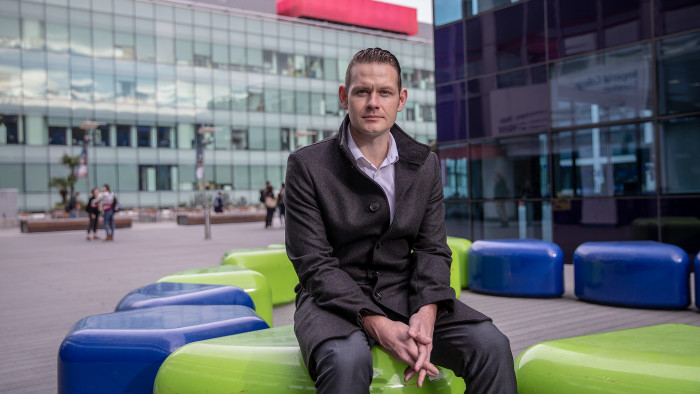Business schools bring AI and VR into the classroom

Simply sign up to the Business education myFT Digest -- delivered directly to your inbox.
As an online MBA student, studying whenever it is convenient, it can take a day for James Connor to get a professor’s help — “a long time when you’re on a deadline”, says the 36-year-old Briton. Soon there may be a more efficient solution for London’s Imperial College Business School students: a smartphone chatbot that will answer queries almost immediately.
The chatbot uses artificial intelligence to find similar questions that have been asked before and provides the answer that was previously deemed to be the best match. Imperial plans to launch the tool on its massive open online courses (Moocs) next month, where tutor time is limited, and eventually on degree programmes.
“The chatbot would be invaluable,” Connor says. “Without immediate access to a tutor, I might spend two or three hours searching for an answer to a problem online.”
David Lefevre, director of the Imperial Edtech Lab that developed the chatbot, says it works well with simple questions, such as “what is a balance sheet?”, but it struggles with less structured queries, in which case a human tutor answers them. “We do not see robots displacing flesh-and-blood faculty,” Lefevre says.
European business schools are on the cutting edge of technology that is transforming the way students learn, give or receive feedback, network and land a job. The use of AI has been fuelled by the need for personalised, continuous learning on a greater scale than before, says Federico Frattini, director of MBA and executive MBA programmes at Italy’s MIP Politecnico di Milano.
About 5,000 students at the school will take skills tests and upload CVs to an AI search engine called Flexa when it launches this month. Developed in partnership with Microsoft, Flexa will recommend which content students should focus on, such as academic papers, in order to plug any gaps in their skills. Students will also share their expertise among themselves and apply for jobs advertised by recruiters through the online platform.
Paolo Mazza, 46, is an MIP EMBA alumnus who tested Flexa. He says the technology is a more efficient way to find useful content. “The vast amount of information on the internet can be overwhelming. Flexa filters it,” he says.
He told the AI search engine he wanted to take his digital transformation company into the healthcare sector and it recommended that he read and watch a series of articles and videos on how technology is affecting the industry. “It was exactly what I needed,” Mazza says.
Anyone will be able to access Flexa free of charge, but they will have to pay a subscription fee of about €10-€15 per month for premium content, such as case studies from top schools. By recommending its own masters courses, MIP hopes to attract more applications for them.
Meanwhile, schools are increasingly using virtual reality because it is becoming more affordable, user-friendly and the visual quality is improving, according to Juliane Iannarelli, chief knowledge officer at AACSB International, the business school accreditation body. “Also, students are demanding that technology is applied to education, as many use it in their personal lives,” she says.
IE Business School in Madrid uses VR to take MBA students to places that may have been inaccessible because of cost, security or safety concerns, for example to an Airbus satellite production line, offering them a rare insight into the aerospace company’s operations.
Students also practise public speaking via VR, which simulates audience reaction, controlled by professors. “Students learn to tailor their communication style, depending on the reaction,” says IE dean Martin Boehm.
The school, an FT partner in the Corporate Learning Alliance, will invest €50m over the next five years in digital technology. According to Boehm, this is partly to compete with online education providers such as Coursera. “We have to invest to remain relevant,” he says.
At Neoma Business School in France, about 2,000 students use VR case studies, such as one where with the help of a 360-degree view, they can learn about marketing by changing a retail shop’s interior.
Estelle François-Brazier this year trialled a VR case during her Neoma Masters in Management degree. She says her engagement, motivation and satisfaction levels were higher than with traditional methods: “It’s an immersive and playful experience that forces you to engage with people to acquire information — not reading it on paper.” One barrier to such immersive technology is the price. It cost Neoma €2,000 to produce a minute of VR case footage. Alain Goudey, the school’s chief digital officer, says another challenge is convincing faculty of VR’s merits. “Many professors remain resistant to change and this could be a barrier to widespread adoption [at other schools],” he says. “We got them on board through demonstrations, so they could see how VR enhances the learning process.”
The next step is using data gathered from VR trials to improve feedback. The UK’s Warwick Business School, for example, plans to use headset eye-tracking capabilities to assess students’ levels of engagement with the teaching. The feedback could be used by professors to improve real-time instruction. The school is also exploring the use of VR to beam lectures to off-campus students.
Ray Irving, Warwick’s director of teaching and learning support, compares the challenge to that faced by the business schools pioneering video lectures in the 2000s. “The [low] bandwidth and corporate firewalls were horrendous issues to deal with, but now video is a staple of business education,” he says. “VR seems like sci-fi, but it will happen.”
Comments